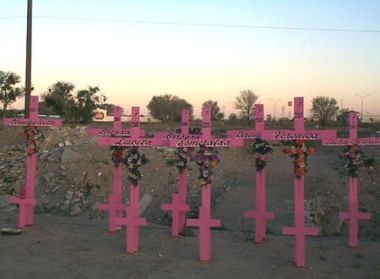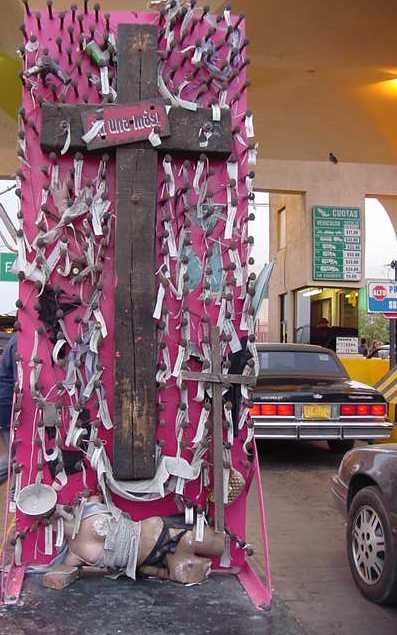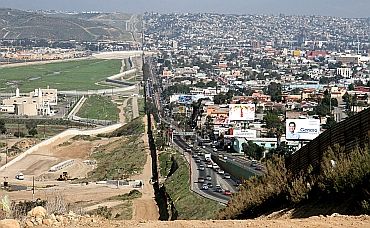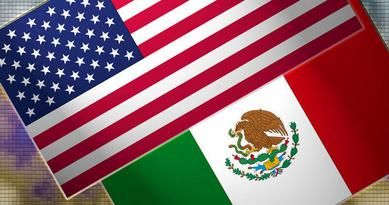
Publisher:
Bonnie King
CONTACT:
Newsroom@Salem-news.com
Advertising:
Adsales@Salem-news.com

~Truth~
~Justice~
~Peace~
TJP
Apr-06-2010 01:05

 TweetFollow @OregonNews
TweetFollow @OregonNews
The Ruins of Juarez
Salem-News.comThe world's most violent city, right next door to the U.S.A.
 Photos courtesy: tomdiaz.files.wordpress.com, Mexicowideweb, smh.com.au, ssteachers.net |
(LAS CRUCES, N.M.) - Approaching Ciudad Juarez from the south, passengers on a commercial bus got a hard look at the world’s most violent city. Halted at a checkpoint outside the city limits, the bus was inspected by Mexican soldiers before being allowed to proceed.
Heading into the crime-torn city, the bus chugged past the twisted piles of steel and mounds of rubble that pock-mark junkyards. Federal police, who arrived in reinforced numbers this month, roamed about on motorcycles or in pick-up trucks.
At the city bus terminal, Mexican soldiers forced passengers to open their bags. Next in line, an official from the National Immigration Institute asked to see identifications.
For those travelers heading on to El Paso, Texas, just across the border, additional inspections awaited before departing the bus station: the random red light/green light search conducted by Mexican Customs and a mandatory one conducted by more Mexican soldiers whose probing hands methodically combed through personal belongings.
Off to El Paso, the bus skirted the Camino Real Hotel, where just the previous day President Calderon spoke to an elite gathering about what might be termed Plan Juarez.
 Among the many victims are dozens of local women and girls. |
Officially, the federal government’s Plan Juarez is touted as a comprehensive response to a multifaceted crisis that has transformed this border city into a war zone between competing criminal gangs.
Plunging into Ciudad Juarez, the bus roared by the endless campaign posters for the Chihuahua gubernatorial campaign and the hefty billboard boasting of the success of the recently completed Conejos-Medanos aqueduct, the privatized water delivery system managed by one of Carlos Slim’s companies.
Zipping through light traffic, the bus glided by empty commercial buildings where “For Sale” or “For Rent” signs proliferated. Fences, gates, iron grills and barbed wire stood out as architectural amenities.
Aesthetically, Ciudad Juarez is a landscape of exclusion and enclosure, with even the view along El Paso’s Paisano Drive on the other side of the Rio Grande blocked by a new fence constructed on the US side.
To keep bus passengers in the mood, a local radio station, 107.5 FM, “La Zeta,” blasted romantic songs and hot cumbias. Ads promoted the opening of a new disco, and recurrent spots from the Federal Electoral Institute proclaimed, “Our Democracy Grows.”
Suddenly, as the bus entered the final approach to the Bridge of Americas leading into El Paso, the traffic came to a halt. Emerging from the shadows, a Mexican soldier scoured commercial trucks with a hand-held drug detection device. Another soldier soon jumped aboard the bus and ordered all the men to get off with their carry-on bags. “Routine revision,” he barked.
One by one, each man was hand-patted and his bags searched. No incriminating evidence was found, and the women passengers were not searched. In all, the bus passengers traveling through Ciudad Juarez that day were stopped, searched, carded or green-lighted/red-lighted six times before arriving to US Customs, where a final id check and baggage scan was carried out. Anyone surviving the Lucky Seven was now on US soil.
Plan Juarez
Despite the deployment of thousands of Mexican soldiers and a reinforced contingent of Federal Police ostensibly to suppress the criminal gangs, violence has only worsened in Ciudad Juarez since January 2008, when the long-simmering drug war exploded in fury.
 Located at the Ciudad Juárez base of the Santa Fe international bridge, |
More than 4,600 people have been slain, and anywhere from 30,000 to 420,000 people have fled from a city that was nudging 1.5 million inhabitants prior to the war, according to wildly varied estimates.
Although it is impossible to know the exact number of refugees due to the silent and secret nature of the population flight, 100,000 or more people might have simply slipped across the Rio Grande to El Paso. Others have fled north to New Mexico or south to Veracruz, among other refuges.
Ciudad Juarez residents had long been fleeing the insecurity of their city, but the 2008 war turned a steady trickle of refugees into a torrent of expatriates.
Coinciding with the deepest economic crisis in decades, about 10,000 businesses have shut their doors in Ciudad Juarez since 2007, according to the Mexican employers’ organization Coparmex. Another business association, the Mexican Chamber of Commerce, estimates that at least 2,000 businesses have suffered extortions at least once. Mom and pop neighborhood stores, the beloved “changarros” of former President Vicente Fox, have been especially hard hit.
The blood of Ciudad Juarez burst onto Mexican national television when 15 people, mostly teenagers, were gunned down at a party held in the Villas de Salvarcar neighborhood on January 30.
Responding to the national outcry, President Calderon rolled out Plan Juarez. Combining a strengthened military and police presence with an initial investment of $50 million in new educational, health, drug rehabilitation and welfare programs, Plan Juarez proposes to reconstruct a shredded social fabric and restore the hegemony of the state.
Headed by Ciudad Juarez native and Secretary of Agrarian Reform Abelardo Escobar, a troika was appointed by President Calderon to oversee a campaign that is officially dubbed “Todos Somos Juarez,” or “We are all Juarez.” The name is an ironic appropriation of the 1994-95 grassroots slogan, “We are all Marcos,” which emerged in support of the Zapatista rebellion in Chiapas.
Echoes of Chiapas surround Plan Juarez. A second member of the troika is iconic National Action Party (PAN) politician Luis H. Alvarez, who served as a point man in the Mexican government’s unsuccessful dealings with the Zapatista rebels.
A textile industrialist by profession and a Chihuahua native by birth, Alvarez has served as mayor of Chihuahua City, federal senator and president of the PAN. With former Chihuahua State Attorney General Arturo Chavez Chavez now at the helm in the federal attorney general’s office, prominent Chihuahenses will have a key hand in steering Plan Juarez.
President Calderon’s plan has received decidedly mixed reviews. For instance, Dr. Felipe Fornelli Lafont, coordinator of directors for the Ciudad Juarez municipal government, wondered aloud how adding 270,000 people to a government-run medical insurance program will play out in a city already beset by insufficient services and a shortage of medical professionals.
“Where are they going to attend them?” Fornelli questioned.
“The infrastructure doesn’t exist.”
The father of Rodrigo Cadena, one of the victims of the Villas de Salvarcar massacre, Adrian Cadena told a Mexican television host he was living the “saddest moments of my life.” Cadena said he trusted Mexican authorities, but stressed that he and other Villas de Salvarcar parents will carefully monitor Plan Juarez. Calling for improved educational access and better sports facilities for youths in Ciudad Juarez, Cadena criticized local schools for charging enrollment and tuition fees.
 U.S. Mexico border |
“If there is some way to relieve the pain, it is to see that young people get professional training, Cadena said”
Civil society activists are divided over participating in the citizen committees formed to help shape Plan Juarez. At a February 17 appearance in Ciudad Juarez, his second visit to the city in one week, President Calderon was shielded by a cordon of soldiers and federal cops.
Outside the Camino Real Hotel, university students and members of the National Front against Repression demanded the resignation of Calderon and the withdrawal of the Mexican army, which has been accused of hundreds of human rights abuses in Ciudad Juarez during the last two years. Besides roughing up five local reporters, federal policemen detained several demonstrators.
Chihuahua state lawmaker Victor Quintana and labor/human rights activist Cipriana Jurado, both prominent critics of the military’s presence and members of the opposition PRD party, were excluded from the February 17 meeting with Calderon.
Disproportionately impacted by the violence, some youths are protesting in the streets or boldly declaring their disgust with political leaders. During a February 22 visit to a high school attended by three of the Villas de Salvarcar victims, Chihuahua Governor Jose Reyes Baeza was scolded by angry classmates of the murdered students.
A tearful 17-year-old identified only as Daniel, questioned the governor: “While you are here, they are killing many (people) outside. Who can tell me that when I leave school I will not be kidnapped or run across a store which is shot up because they did not pay the (extortion) quota?”
Juarez is Mexico…and the US
Villas de Salvarcar thrust Ciudad Juarez, a place viewed by many residents of the Mexican interior as a remote, god-forsaken hellhole, into the national spotlight. For days, the massacre and subsequent government response dominated the headlines and airwaves. A columnist and political analyst for the Aguascalientes edition of the national daily La Jornada, Fernando Rivera has a friend in Ciudad Juarez who is shutting down his business and moving to El Paso. Rivera wrote a column in La Jornada this month entitled “Juarez is Mexico.”

In an interview with Frontera NorteSur, Rivera said a grave situation exists in a city that has “more deaths than Iraq” but is located in a nation where “supposed freedom and democracy” prevail.
Concerned the Ciudad Juarez Syndrome could take hold across Mexico, Rivera cited the recent cases of two youths from Leon, Guanajuato, who were accused of being hired killers.
“They were ready to die for $200 every two weeks or $400 every month,” Rivera said. “I’m not afraid of the Mexico I am going to leave my son. I am afraid of the Mexico I live in,” he added.
A media critic, Rivera expressed skepticism that national coverage of Ciudad Juarez will extend beyond President Calderon’s trips before reverting back to trivial obsessions like the condition of singer Alejandra Guzman’s buttocks. Rivera compared Ciudad Juarez to Chiapas in 1994, when the Zapatista uprising resulted in an infusion of government money but little or no structural change in the social, political and economic order that provoked violence in the first place.
What’s more, the writer added, killings like the 1997 massacre of scores of civilians in Acteal, Chiapas, have largely gone unpunished and left a bitter legacy of criminal impunity and historical denial.
“We can’t be like ostriches with our necks stuck in the ground and our bodies above it, and evade responsibility,” Rivera asserted. “We can’t forget Juarez. They are my countrymen. They are Mexicans.”
In a separate interview, Dr. Howard Campbell, professor of anthropology at the University of Texas at El Paso, told Frontera Norte the violence in his sister city had personally impacted students from Ciudad Juarez who attend the US campus.
The author of a new book chronicling the deep-rooted narco-culture that permeates both El Paso and Ciudad Juarez, Campbell said Villas de Salvarcar could mark a watershed in the violence that was allowed to rip apart the Mexican border city.
“It was sad to see killings without any protests,” Campbell said. “The Villas de Salvarcar massacre has finally prompted people in both cities to organize, to pressure, to do anything they can.”
Together with other intellectuals and civic leaders, Campbell supported a February 9 resolution of the El Paso City Council that condemned the Ciudad Juarez violence and urged Washington to make Mexico a foreign policy priority.
But Campbell was also skeptical that Plan Juarez and “whirlwind” tours by President Calderon and other politicians could succeed in rebuilding a city that is fast becoming what amounts to a vast and violent holding pen for the poor.
“What they need is a Marshall Plan for the city.” Campbell contended. “What they’re getting is a few bones.”
The Pharaoh of Vice
The decay of Ciudad Juarez is evident to any pedestrian who saunters across the Santa Fe Bridge from El Paso to the once-bustling but now subdued Avenida Juarez. A shuttered door with a painted image, dripping red in simulation of blood, sums up the scene: “Sufferings because of these hired killers.”
Hanging next to the message, a faded poster appealed for information on the whereabouts of 43-year-old Manuela Juarez Varela, one of hundreds or even thousands of people reported vanished and forgotten in the border’s mean bowels. Down the street, a big electronic bulletin flashed news of the latest decapitations in Michoacan to the south.
Behind the Avenida, off to the right, stands the remains of the legendary Mariscal red light district, which is getting razed for gentrification.
Once the cross-border center of fun, foolishness and fraud, the Mariscal is a shell of its former self. Displayed yards from the walls where a painted Frida Kahlo butterfly and anti-femicide graffiti blend into a semi-psychedelic, gender conscious street mural, a missing persons’ poster for 17-year-old Jessica Monserrat rose up over the rubble.
Across the street, the collapsing Pharaoh-like head above the entrance of the old Las Vegas Club signaled the end of an old empire and the possible beginning of a new one.
A man who billed himself as a “security guard” complained the urban renewal will throw many people out of work-barmen, sex workers, fast food sellers, flower peddlers and the like. “The situation is going to be bad for people who work here,” he predicted.
A hint of what could be in store for the new unemployed was found on the nearby Santa Fe Bridge. On a late Friday afternoon, usually a peak travel time back to El Paso, the bridge was eerily deserted. At one point, not even a single car was spotted on the hump of the crossing that unites the world’s most dangerous city with one of the safest ones in North America.
While beggars were always part of the bridge scene, the panhandlers seemed more numerous and desperate than ever before. Almost tugging at walkers’ shirt- sleeves, insistent voices refused to take no for an answer and kept pleading for a few pesos.
Back in the news cycle, Ciudad Juarez television stations and newspapers resumed their daily barrage of guns, guts and gore. A man named Jose Guadalupe Chavez was shot and killed at a mechanic’s shop. A 19-year veteran homicide investigator for the Chihuahua state attorney general’s office, Enrique Castaneda Ogaz, was gunned down elsewhere. An additional victim was slain in broad daylight practically under the noses of the soldiers and federales stationed in and around the Santa Fe Bridge.
As US soldiers from burgeoning Ft. Bliss rubbed shoulders with trendy, young Juarenses in El Paso’s thriving nightclubs, the US media flashed images and sound-bites of wars in Afghanistan and Pakistan. Growing tensions over Iran and the Israeli Hamas assassination scandal were other stories. Locally, two El Paso-area men were arrested for kidnapping another man on the US side and delivering him to Ciudad Juarez for slaughter.
But the big story of the day, repeated over and over, was Tiger Woods’ public apology.
Additional sources:
- Arrobajuarez.com, February 22, 2010
- El Diario de El Paso, February 20, 2010, Articles by Martin Orquiz and Sandra Rodriguez Nieto.
- Lapolaka.com, February 17 and 20, 2010
- Channel 44 (Ciudad Juarez), February 18 and 19, 2010
- El Semanario de Nuevo Mexico, February 18, 2010
- Diario de Juarez, February 17 and 18, 2010, Articles by M. Coronado, Araly Castanon, Blanca Carmona and editorial staff
- Milenio TV, February 17, 2010
- Norte, February 17, 2010. La Jornada, February 17, 2010
- El Paso Times, February 9, 16 and 23, 2010
- Articles by David Burge and Adriana Gomez Licon
- Televisa, February 15, 2010. Pagina 24/El Universal, February 13 and 16, 2010
- Wikipedia.org
Special thanks to Frontera NorteSur
Articles for April 5, 2010 | Articles for April 6, 2010 | Articles for April 7, 2010

Quick Links
DINING
Willamette UniversityGoudy Commons Cafe
Dine on the Queen
Willamette Queen Sternwheeler
MUST SEE SALEM
Oregon Capitol ToursCapitol History Gateway
Willamette River Ride
Willamette Queen Sternwheeler
Historic Home Tours:
Deepwood Museum
The Bush House
Gaiety Hollow Garden
AUCTIONS - APPRAISALS
Auction Masters & AppraisalsCONSTRUCTION SERVICES
Roofing and ContractingSheridan, Ore.
ONLINE SHOPPING
Special Occasion DressesAdvertise with Salem-News
Contact:AdSales@Salem-News.com

Salem-News.com:
googlec507860f6901db00.html

Terms of Service | Privacy Policy

All comments and messages are approved by people and self promotional links or unacceptable comments are denied.
[Return to Top]
©2025 Salem-News.com. All opinions expressed in this article are those of the author and do not necessarily reflect those of Salem-News.com.